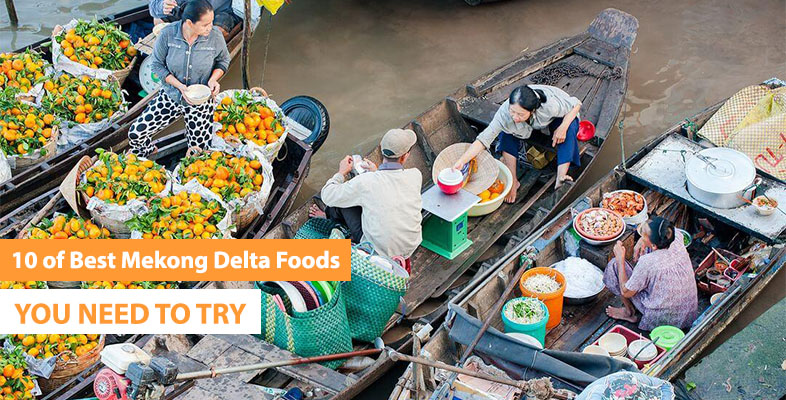
- On 7 August, 2020
- In ALL BLOGS VIỆT NAM BLOGS
- Tags Tags: food, mekong, mekong delta
10 OF BEST MEKONG DELTA FOODS YOU NEED TO TRY
From the Tibetan highlands to the lowlands of southwest Việt Nam, the Mekong River and its thousands of tributaries meanders across 39,000 square kilometers (15,000 square miles) in Vietnam known as the Mekong Delta, encompassing the lands immediately west of Hồ Chí Minh City to the country’s southern most tip, Cà Mau.
Known as a biological treasure trove, the Mekong River sustains more than 17 million inhabitants along its banks in Việt Nam’s delta region. Its waters and rich soil help to produce half of the country’s rice crop each year, as well as an abundance of fruits. The delta is also home to a large aqua-cultural industry raising catfish, shrimp, and basa – a fish native to the delta.
The common aspects of Mekong Delta dishes are honesty, simplicity and rusticity. But it is also meticulous in the way of processing. The irresistible attraction to southern cuisine comes from the perfect blend between rustic and fine features in every dish.
Here are our choice of 10 of best Mekong Delta foods that you need to try!
- Mekong Delta Styled Pancakes
- Sweet and Sour Soup
- Deep-fried Elephant-ear Fish
- Poached Prawns in Coconut
- Hủ Tíu Noodle Soup
- Banana Flower Salad with chicken
- Stir-fried Thiên Lý flowers with garlic
- Caramel Clay-pot Fish
- Grilled Mekong Fish
- Braised chicken with lemongrass
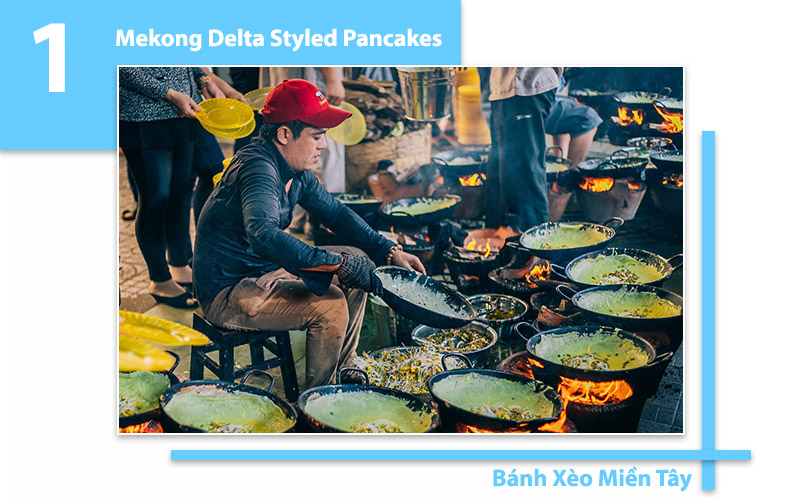
You can easily see the golden crispy fried pancake called “bánh xèo” in the Central and South Việt Nam. It literally means “sizzling pancake” named for the loud sizzling sound it makes when the rice batter is poured into the hot skillet which is a Vietnamese savory fried pancake made of rice flour, water, turmeric powder.
Some wonder about the difference between the pancakes in the Central Việt Nam and in the Mekong Delta. The distinction is the size: the pancake of the Mekong Delta is much larger than that in the central region. In addition, the pancake in the central region is poured in a mold, while the pancake in the Mekong Delta is poured into a large pan.
The attractiveness of the Mekong Delta pancake is the thin crispy crust. When enjoying this dish, you will feel pieces of pancake melt right in your mouth. Fillings are varied, depending on each region but in the Mekong Delta, it includes bean sprouts, mushrooms, bacon, shrimp, chicken meat, chopped duck meat and other vegetables like leaf lettuce, Thai basil, and mint. Particularly, the pancake made from the Forbidden Mountain in An Giang use the best mountain vegetables.

Canh Chua is the most popular soups in the Mekong Delta. We adore Canh Chua because the contrasting flavors of sour, sweet, and savory and we also love the contrasting textures of all the different vegetables. Literally translated as “sour soup”, it combines all the wonderful abundance of this region, incorporating seafood (such catfish, snake-head fish, eel, and shrimp among others) along with colorful medley of tamarind, pineapple, tomatoes, okra, bean sprouts, and a variety of herbs such as lemony ngò ôm. Enjoy canh chua with some steamed jasmine rice as part of a traditional Vietnamese meal or alone with some rice vermicelli noodles.
Due to its nutritional value, health benefits, and short cooking time, canh chua has the status of a quintessential Vietnamese meal.
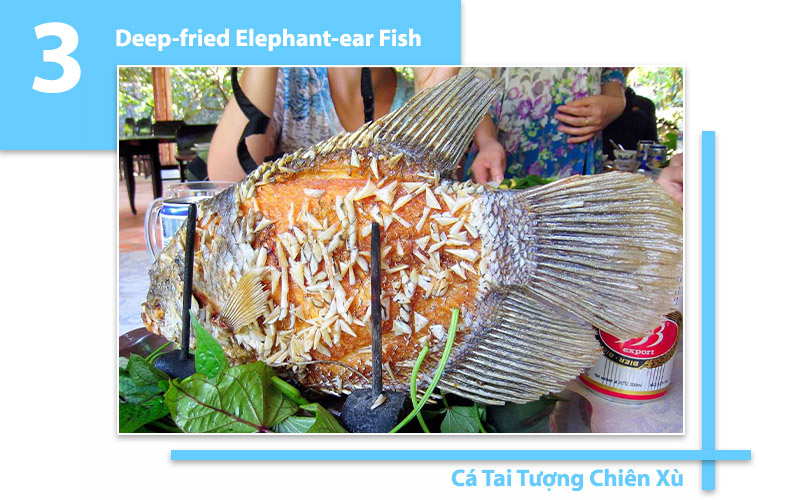
Being crispy outside but tender inside, smelling, pretty delicious and healthy is highlight of Deep-fried Elephant-ear Fish, Cá Tai Tượng Chiên. Giant gourami is a kind of freshwater fish weighing 0.5-1.5 kg. In Mekong Delta, they live in ponds and rivers and are called Elephant-ear fish because it looks like an elephant’s ear. The interesting thing of Deep-fried Elephant-ear Fish is that the cook doesn’t remove the fish scales and fins. The cook must be patient, skillful and experienced enough to fry whole fish in a big pan at high temperature. Oil should cover the fish and be hot enough to make sure the fish scales and fins still remains and become crispy.
Deep-fried Elephant-ear Fish must be served hot using a special wooden tool which you can see on below photo. It is usually eaten with steamed rice, vegetables, herbs and sweet, sour and hot fish sauce dip. Instead of steamed rice, it can be eaten with rice paper and rice noodles. Just use rice paper to wrap a piece of crispy fish, salad, cucumber, herbs, star fruit slices, green banana slices, and rice noodles into a medium roll. Then dip the roll into fish sauce dip and tuck in. Some prefer dipping this food with “Mắm nêm” – a sauce made of fermented fish. Some cooks make tomato sauce or pineapple sauce to pour on the fish and top it with crushed peanuts.
Mekong Delta is full of rivers, channels, ponds, swamps and lakes with lots of fishes, elephant-ear fish is easy to catch there. Do not miss trying Deep-fried Elephant-ear Fish on your trip to this peaceful and beautiful region. There you will have chance to enjoy a flavorful dish from freshest vegetables, herbs and fish as well as savory rice noodles, fish sauce, “Mắm nêm” made by locals.
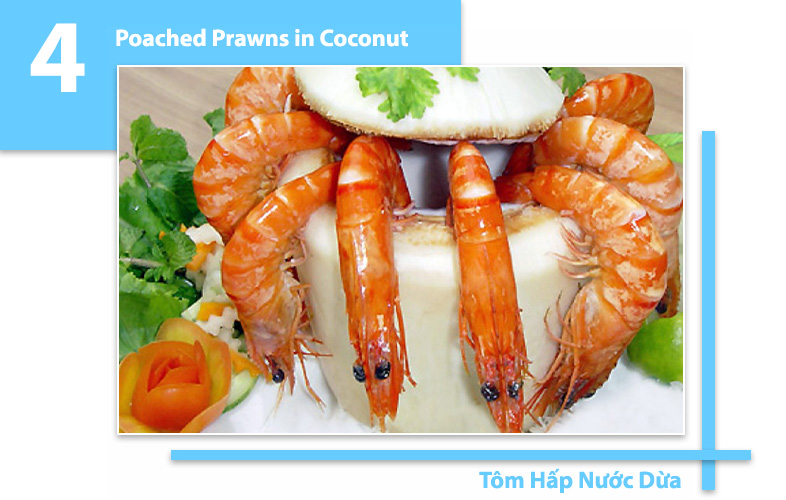
Prawns are very versatile ingredients that could be used in different way of cooking methods such as deep-fried, steamed, and grilled and etc. In Mekong Delta culinary Tôm Hấp Nước Dừa, poached prawns in coconut juice, is one of common ways of cooking live prawn which you could easily find at local restaurants.
For seafood, coconut water especially helps to impress the sweetness from both ingredients. Beside the light aroma from the coconut fruit is also to help to decrease a little bit the typical fishy smell from the seafood. In many seafood restaurants, coconut fruit is one of the ingredients that contribute the seafood dishes as art in cuisine both flavor and decoration.
In Mekong Delta, We usually use live river prawns for this dish and it is steamed in young coconut juice which is very simple and easy to be prepared. And by soaking the prawns into the coconut juice it would also increases the sweet and delicious flavor of the dish.
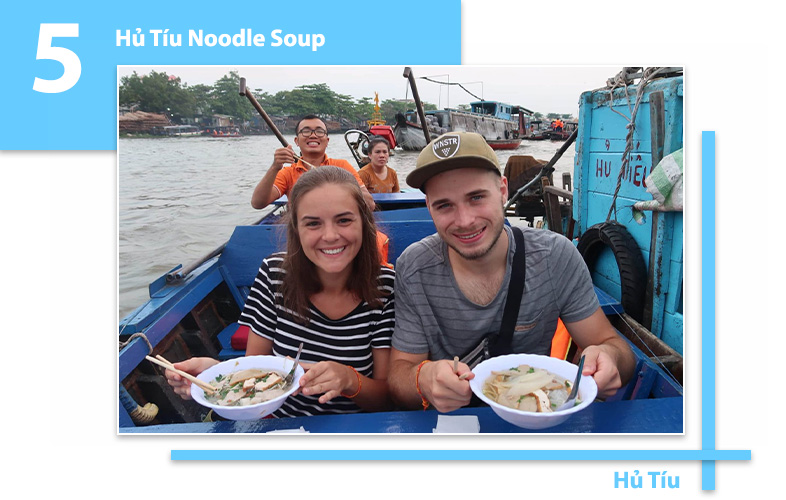
When we mentioned about Vietnamese noodle soup, people always think of Phở, the worldwide noodle soup; but actually, there are also many kinds of Vietnamese noodle soup that we don’t know how to translate into English or any other languages. One of the most famous noodles in the Mekong Delta is “Hủ Tíu”.
Hủ Tíu is one such variation, coming from different towns in Mekong Delta. As with most food in the region, this dish features at least a nod to the Mekong Delta’s strong fishing culture, with prawns set amongst pork and liver, while variations within this regional variation can feature fish balls or squid. Added vegetables like spring onion, shallots and chives are all optional, but they invariably sit in a colorful bowl, swimming in a pork stock soup.
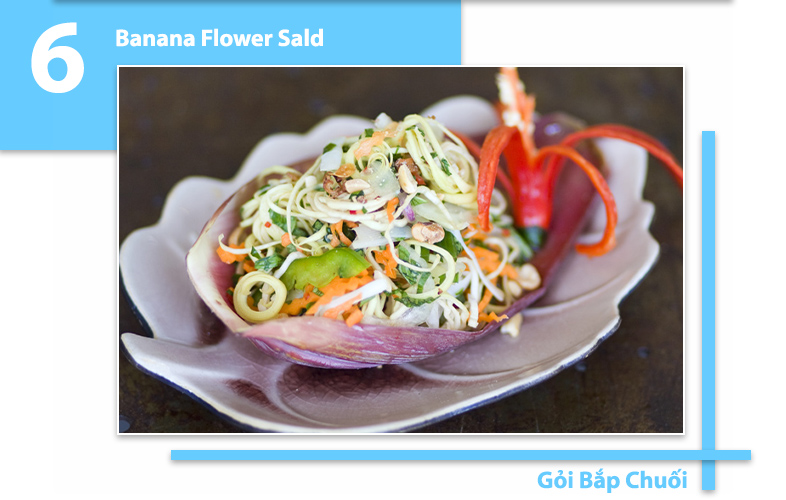
Banana flower salad is an authentic Mekong Delta dish. Today, this dish is considered as a specialty in Vietnam cuisine. It is called “gỏi bắp chuối”. It is a combination of different flavors and texture contrasts. This crunchy banana flower salad is made from banana flower and then tossed in tamarind and peanuts. This dish is loaded with many essential vitamins and the sour and sweet taste of lemon and jaggery.
Besides, canola oil also makes a great addition to this dish thanks to its neutral taste and light texture. This dish is not only extraordinary to look at, but it is also incredibly flavorful. Just enjoy every bite to enjoy the crispiness of banana flower and pig ears, the subtle flavor of herbs, the chewy taste of chicken, the harmony of the salad dressing and the nutty flavor of crushed roasted peanut. Actually, this dish is worth trying.
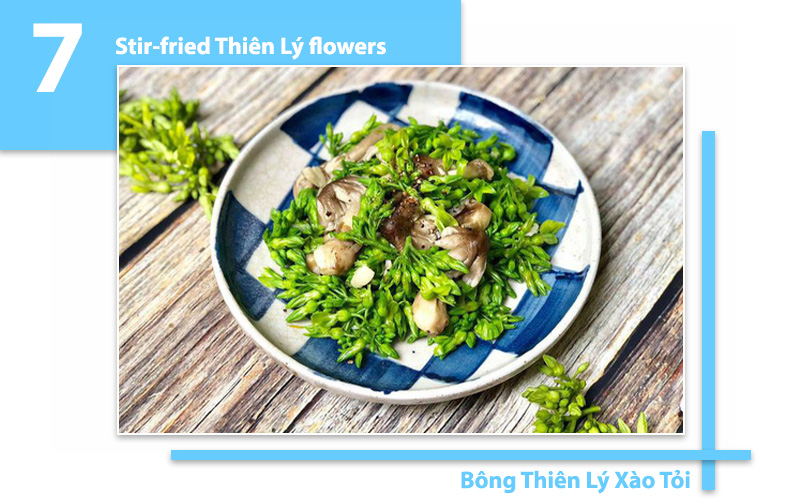
Tonkin jasmine or Tonkin creeper flowers can be found all around Mekong Delta and Việt Nam. They are called “bông thiên lý”, “hoa thiên lý” or “dạ lý hương”, because they bloom at night and smell like Ylang Ylang flowers. Besides being used in traditional medicine, Tonkin jasmine flowers are also a great ingredient for cooking.
One delicious dish with Tonkin jasmine flowers, which is a kind of a staple in Vietnamese meals, is Stir-fried Tonkin Jasmine Flowers with garlic (prawn or beef). When cooked, the flowers turn bright green and start tasting like green peas, with a very slight scent of perfume.
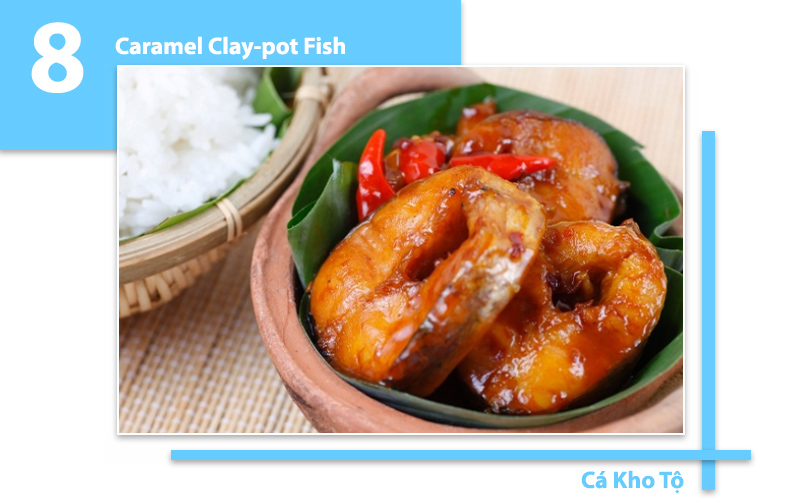
A staple of any Vietnamese cook’s repertoire is “kho” (pronounced “khaw”) or stewed meat, most often in a caramel sauce with fish sauce for that addictive sweet and salty combination.
Anabas and snakehead are two of the most common fishes one will see during a meal in this delta. There are many ways to cook them, including frying them in sweet and sour fish sauce or cooking with vegetables to make a soup.
However, braising is one of the most common methods of cooking them. The fish is marinated with spices in a clay pot over low heat to soften it. Once cooked, the flavorful fish is eaten with rice. Each family has its own recipe and sauces that give the dish an endless variety of tastes. Cá Kho Tộ is known for its intense sweet-salty flavour, so this dish is always served with a plate of white rice and fresh greens.
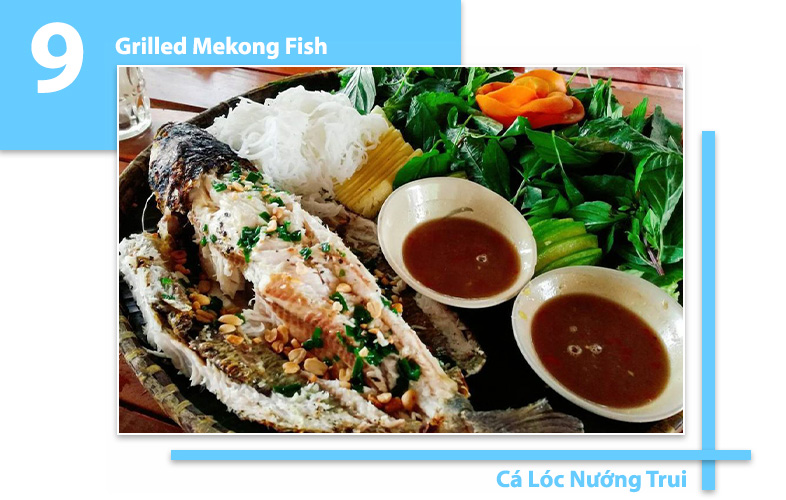
Grilled Fish is one of the most delicious foods with a wide variety of fresh fishes and taste crunch from Mekong River that you must try. The grilled fish is sure to impress on your table, bursting with the taste from garlic, chili, pepper, salt spread in fish skin. It is served with rice noodles, some kinds of vegetables of cucumber, green banana, herbs and star fruit and fish sauce.
Grilled snake-head fish are processed by Southern farmers after work end. Snake-head fish caught in the river just up, washed, are regularly using a long stick from mouth to tail, after burying the fish on dry haystack on fire, then plug the stick into the ground or get covered up and burning straw until the ashes. When fish cooked, scrape off the scales were scorched layer to reveal white meat and fragrant.
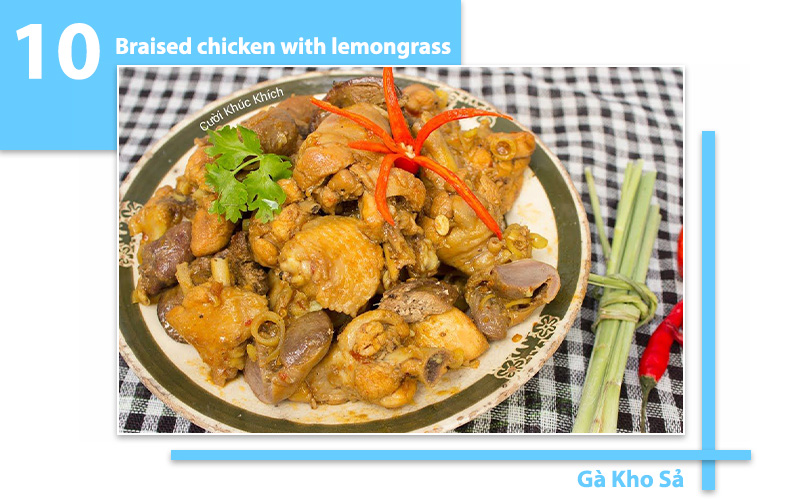
Gà Kho Sả (Braised chicken with lemongrass) is a common specialty in Central and South Vietnam because it is simple from the recipe to the ingredients.
As the name suggests, the most important things to make Gà Kho Sả are chicken and lemongrass. It also needs other ingredients such as coconut water, ginger, onion, coriander, and spices: fish sauce, sugar, pepper, soup powder in a suitable ratio to create a delicious Braised chicken with lemongrass and hot chili dish.
This combination will then be braised in 30 minutes to one hour to be completed. You can eat Braised chicken with lemongrass and hot chili with cooked rice to enjoy its full taste.

